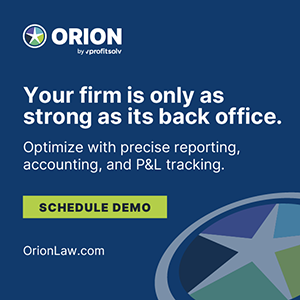MANAGING COST
Legal administrators and law firm leaders play a critical role in managing resources to ensure the firm delivers high-quality client service while maintaining long-term financial sustainability. Costs related to technology, personnel and daily operations are under constant scrutiny. For in-house administrators, the responsibility is often even greater, particularly when it comes to justifying the return on investment (ROI) for new technology. The effort to encourage a value-driven approach to decision-making typically falls to administrative professionals. Fortunately, AI is proving to be one of the most effective solutions to achieving these goals.
Effective use of AI rests on leveraging its potential to improve efficiency while maintaining the critical human touch necessary to guard against inappropriate use of this technology.
Last year showed us that AI-powered solutions already are automating time-consuming tasks such as billing, document review and case management, significantly cutting administrative overhead. This year, more widespread adoption of AI tools will enable legal administrators to achieve even greater financial oversight. For example, AI systems can analyze time entries and invoices to ensure accuracy, flag inconsistencies and identify potential overbilling errors. Predictive analytics will further empower legal teams to forecast project or case-related costs with greater accuracy, improving budgeting and resource allocation.
Staffing often is the most significant cost challenge for administrators, particularly in high-volume practices. AI-powered workforce solutions can revolutionize staffing processes by offering real-time insights into staffing needs and workload distribution. These solutions help administrators optimize resource allocation, ensuring the right tasks are assigned to the right people while avoiding costly overstaffing or underutilization. This strategic approach not only helps control costs but also enhances operational efficiency and service quality.
MITIGATING RISK
Artificial intelligence increasingly is becoming indispensable for risk management across the legal profession. AI-driven solutions designed for legal research already are expediting processes by sifting through large volumes of case law, statutes and contracts, reducing the time and expense associated with manual research. What’s new in 2025 is more reliance on contract management systems using NLP to help identify and mitigate risks, ensuring compliance and preventing costly disputes. Automating tedious tasks like monitoring expiring contracts allows legal administrators and paralegals to focus on higher-priority responsibilities.
Like contract management systems, AI-powered deposition summaries also will change the way legal administrators work. By incorporating state-of-the-art LLMs with advanced NLP capabilities, practitioners now have a more accurate and nuanced understanding of long-narrative formats. Harnessing the power of these AI solutions enables legal teams to quickly grasp critical themes or pinpoint key details buried within complex deposition narratives. These tools not only improve efficiency but also enhance the strategic value of the insights derived.
Both tools mitigate risk and create efficiencies for law firm administrators and their corporate counterparts. By eliminating error-prone routine tasks, administrators can focus on the big-picture priorities that otherwise might be sacrificed in the blur of daily litigation and complex corporate transactions, such as training and continuing legal education (CLE) compliance, team building and human resources tasks, or having extra time to manage month-end or year-end processes.
ENHANCING COMPLIANCE
Compliance is another area where legal administrators can look to technology to help firms meet regulatory requirements with greater accuracy. Secure, encrypted environments powered by AI are lending a hand in managing sensitive data while adhering to industry-specific regulations, such as HIPAA for healthcare-related cases. Centralized AI-powered document tracking systems are another significant innovation. These systems allow legal administrators to monitor the progress of record requests, ensuring clear documentation and proper audit trails, which ease compliance with legal and procedural standards.
Beyond day-to-day compliance tasks, corporate compliance professionals and legal administrators must navigate the dual challenges of adopting AI responsibly while managing new compliance challenges. With the rising complexity of legal data and regulatory demands, there is a growing need for platforms that provide real-time updates and analysis of legal and regulatory changes. While most of these regulation-focused AI solutions are still in the nascent stage of development, legal professionals will need them to remain compliant and make informed decisions. For example, AI-driven tools could help organizations navigate complex regulatory landscapes by identifying emerging compliance issues and recommending remedial actions.
GAINING A COMPETITIVE EDGE
AI’s ability to enable predictive analytics and trend forecasting is revolutionizing decision-making in legal administration. By reducing dependence on manual, labor-intensive work, administrators gain the time they need to focus on strategies that drive growth and improve profitability. Automated systems also ensure greater accuracy, boosting confidence in data-driven decisions.
Leveraging AI in areas such as cost management, risk mitigation and compliance will both enhance efficiency and position legal organizations to maintain a competitive edge in an increasingly demanding landscape. For legal administrators, the future is bright; with AI as an ally, they can focus on advancing their firms' strategic goals while ensuring exceptional service for clients.
Ultimately, adopting AI now is no longer optional for law firms — it is essential for long-term success. By responsibly equipping their teams with these cutting-edge tools, legal administrators are investing in a future where efficiency, precision and innovation define their practice.





